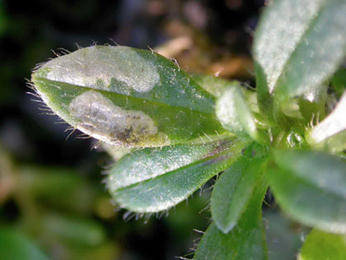|
||||||
|
POLYCARPON. Four-leaved Allseed. [Caryophyllaceae] |
|
Four-leaved Allseed (P. tetraphyllum) is the only species of Polycarpon recorded in Britain. It is an introduced species. Only one British miner is recorded on Polycarpon. A key to the European miners recorded on Polycarpon is provided in Bladmineerders van Europa. |
Key for the identification of the known mines of British |
1 > Leaf-miner: The mine starts as a long, narrow, winding corridor running towards the midrib, widening to a blotch. Usually upper-surface, but in small leaves also full-depth parts may occur. The blotch has broad lobes; in their ends most frass is accumulated in the form of green patches or clouds. Sometimes several larvae share mine. Pupation usually in the soil, less often in the leaf (and then generally not in the mine itself but in a small separated mine, that may even be made in the petiole). |
 Mine of Scaptomyza graminum on Cerastium glomeratum Image: © Jean-Yves Baugnée (Bladmineerders van Europaa) |
|
Scaptomyza graminum (Fallén, 1823) [Diptera: Drosophilidae]. |
| Last updated 06-Jul-2019 Brian Pitkin | ||
